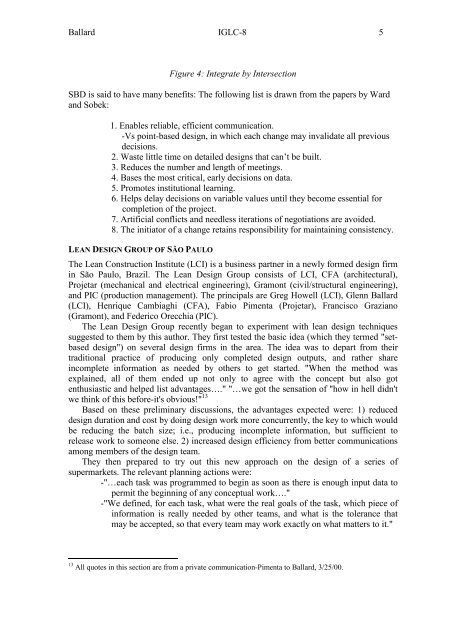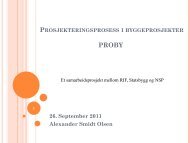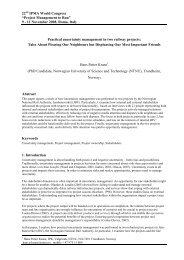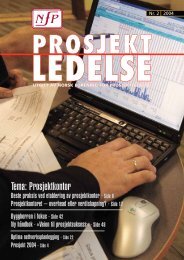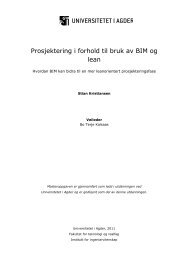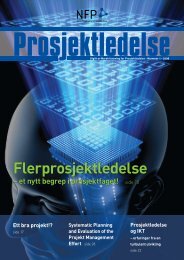positive vs negative iteration in design - Lean Construction Institute
positive vs negative iteration in design - Lean Construction Institute
positive vs negative iteration in design - Lean Construction Institute
Create successful ePaper yourself
Turn your PDF publications into a flip-book with our unique Google optimized e-Paper software.
Ballard IGLC-8 5Figure 4: Integrate by IntersectionSBD is said to have many benefits: The follow<strong>in</strong>g list is drawn from the papers by Wardand Sobek:1. Enables reliable, efficient communication.-Vs po<strong>in</strong>t-based <strong>design</strong>, <strong>in</strong> which each change may <strong>in</strong>validate all previousdecisions.2. Waste little time on detailed <strong>design</strong>s that can’t be built.3. Reduces the number and length of meet<strong>in</strong>gs.4. Bases the most critical, early decisions on data.5. Promotes <strong>in</strong>stitutional learn<strong>in</strong>g.6. Helps delay decisions on variable values until they become essential forcompletion of the project.7. Artificial conflicts and needless <strong>iteration</strong>s of negotiations are avoided.8. The <strong>in</strong>itiator of a change reta<strong>in</strong>s responsibility for ma<strong>in</strong>ta<strong>in</strong><strong>in</strong>g consistency.LEAN DESIGN GROUP OF SÃO PAULOThe <strong>Lean</strong> <strong>Construction</strong> <strong>Institute</strong> (LCI) is a bus<strong>in</strong>ess partner <strong>in</strong> a newly formed <strong>design</strong> firm<strong>in</strong> São Paulo, Brazil. The <strong>Lean</strong> Design Group consists of LCI, CFA (architectural),Projetar (mechanical and electrical eng<strong>in</strong>eer<strong>in</strong>g), Gramont (civil/structural eng<strong>in</strong>eer<strong>in</strong>g),and PIC (production management). The pr<strong>in</strong>cipals are Greg Howell (LCI), Glenn Ballard(LCI), Henrique Cambiaghi (CFA), Fabio Pimenta (Projetar), Francisco Graziano(Gramont), and Federico Orecchia (PIC).The <strong>Lean</strong> Design Group recently began to experiment with lean <strong>design</strong> techniquessuggested to them by this author. They first tested the basic idea (which they termed "setbased<strong>design</strong>") on several <strong>design</strong> firms <strong>in</strong> the area. The idea was to depart from theirtraditional practice of produc<strong>in</strong>g only completed <strong>design</strong> outputs, and rather share<strong>in</strong>complete <strong>in</strong>formation as needed by others to get started. "When the method wasexpla<strong>in</strong>ed, all of them ended up not only to agree with the concept but also gotenthusiastic and helped list advantages…." "…we got the sensation of "how <strong>in</strong> hell didn'twe th<strong>in</strong>k of this before-it's obvious!" 13Based on these prelim<strong>in</strong>ary discussions, the advantages expected were: 1) reduced<strong>design</strong> duration and cost by do<strong>in</strong>g <strong>design</strong> work more concurrently, the key to which wouldbe reduc<strong>in</strong>g the batch size; i.e., produc<strong>in</strong>g <strong>in</strong>complete <strong>in</strong>formation, but sufficient torelease work to someone else. 2) <strong>in</strong>creased <strong>design</strong> efficiency from better communicationsamong members of the <strong>design</strong> team.They then prepared to try out this new approach on the <strong>design</strong> of a series ofsupermarkets. The relevant plann<strong>in</strong>g actions were:-"…each task was programmed to beg<strong>in</strong> as soon as there is enough <strong>in</strong>put data topermit the beg<strong>in</strong>n<strong>in</strong>g of any conceptual work…."-"We def<strong>in</strong>ed, for each task, what were the real goals of the task, which piece of<strong>in</strong>formation is really needed by other teams, and what is the tolerance thatmay be accepted, so that every team may work exactly on what matters to it."13 All quotes <strong>in</strong> this section are from a private communication-Pimenta to Ballard, 3/25/00.


